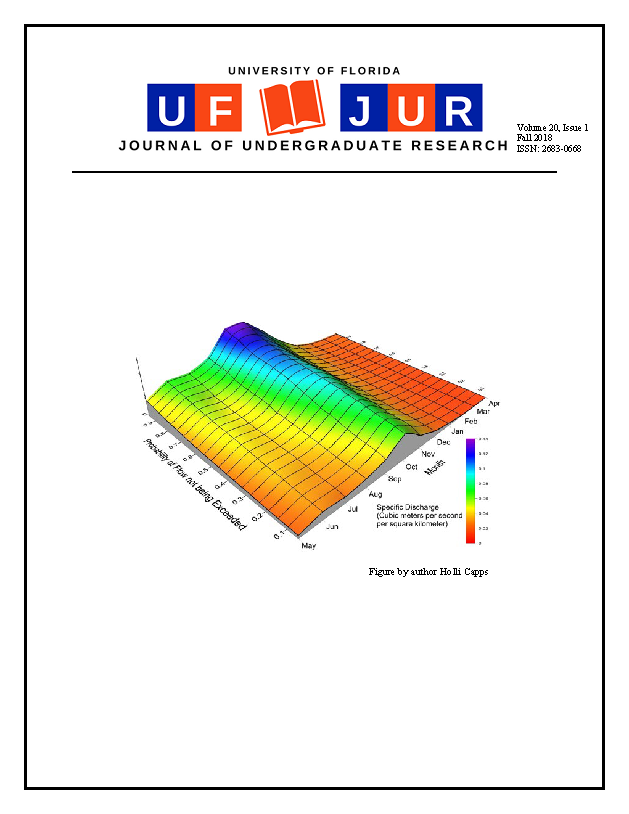Emerging Diagnosis Improvements and Treatments of Mild to Traumatic Brain Injuries
DOI:
https://doi.org/10.32473/ufjur.v20i1.106908Keywords:
Review Paper, Undergraduate Research, AMAAbstract
This review paper evaluates the current clinical and research practices for diagonising and treating TBI and mTBI. It provides an overview of the new emerging treatments for mTBI and TBI that are in varying stages of research. The paper analyzes the shortcomings and practices of diagnosing mTBI and TBI and also evaluates new and potentially break-through mTBI and TBI treatments such as Iron Chelators, Cellular Therapy, Cannabinoid Receptor Treatment, Electroaccupuncture, and Transcanial Magnetic Stimulation. While the current method of diagnosis for severe TBI is sound, mTBIs remain largely undiagnosed or misdiagnosed. This paper identifies the limitations of current neuroimaging and diagnostic techniques for mTBI and TBI. There are many current treatments for the primary symptoms/damage of TBI and mTBI (severe swelling, trauma, neuroinflammation, edema, diffuse axonal damage, and loss of consciousness). However, there is little or no treatment for secondary injuries (personality shifts, free iron collection, cognitive deficits in short-term memory, abstract reasoning, and many unique deficits dependent on the site of injury). This review paper seeeks to evaluate emerging research and diagnostic methods and explores possible new directions for diagnosis and conceivable conjunction therapies to treat multiple aspects and deficits of mTBI and TBI.
Metrics
References
Arciniegas DB, Anderson CA, Topkoff J, McAllister TW. Mild traumatic brain injury: a neuropsychiatric approach to diagnosis, evaluation, and treatment. Neuropsychiatric Disease and Treatment. 2005;1(4):311-327.
Bose P, Hou J, Thompson F. Traumatic Brain Injury (TBI)-Induced Spasticity: Neurobiology, Treatment, and Rehabilitation. Brain Neurotrauma Frontiers in Neuroengineering Series. May 2015:155-166. doi:10.1201/b18126-17.
Bu W, Ren H, Deng Y, et al. Mild Traumatic Brain Injury Produces Neuron Loss That Can Be Rescued by Modulating Microglial Activation Using a CB2 Receptor Inverse Agonist. Frontiers in Neuroscience. 2016;10. doi:10.3389/fnins.2016.00449.
Cox CS. Cellular therapy for traumatic neurological injury. Pediatric Research. June 2017. doi:10.1038/pr.2017.253.
Devoto C, Arcurio L, Fetta J, et al. Inflammation Relates to Chronic Behavioral and Neurological Symptoms in Military with Traumatic Brain Injuries. Cell Transplantation. 2016. doi:10.3727/096368916x693455.
Eierud C, Craddock RC, Fletcher S, et al. Neuroimaging after mild traumatic brain injury: Review and meta-analysis. NeuroImage: Clinical. 2014;4:283-294. doi:10.1016/j.nicl.2013.12.009.
Englander J, Cifu DX, Diaz-Arrastia R. Seizures after Traumatic Brain Injury. Arch Phys Med Rehabil. 2014;95(6):1223-1224. doi:10.1016/j.apmr.2013.06.002.
Inglese M, Makani S, Johnson G, et al. Diffuse axonal injury in mild traumatic brain injury: a diffusion tensor imaging study. Journal of Neurosurgery. 2005;103(2):298-303. doi:10.3171/jns.2005.103.2.0298
Jenna L Leclerc, Juan Santiago-Moreno, Alex Dang, et al. Increased brain hemopexin levels improve outcomes after intracerebral hemorrhage. J Cereb Blood Flow Metab. November 2016:0271678X16679170. doi:10.1177/0271678X16679170
Joseph B, Pandit V, Kulvatunyou N, et al. Mild traumatic brain injury defined by Glasgow Coma Scale: Is it really mild? Taylor and Francis - Brain Injury. 2014;29(1):11-16. doi:10.3109/02699052.2014.945959.
Kogan NM, Mechoulam R. Cannabinoids in health and disease. Dialogues in clinical neuroscience. 2007;9(4):413-430. https://www.ncbi.nlm.nih.gov/pmc/articles/PMC3202504/. Accessed October 25, 2017.
Kosaka B. Neuropsychological assessment in mild traumatic brain injury: A clinical overview. BCMJ. 2006;4(9):447-452.
Lu H, Kobilo T, Robertson C, Tong S, Celnik P, Pelled G. Transcranial magnetic stimulation facilitates neurorehabilitation after pediatric traumatic brain injury. Scientific Reports. 2015;5(1). doi:10.1038/srep14769.
Margulies S, Hicks R, The Combination Therapies for Traumatic Brain Injury Workshop Leaders. Combination Therapies for Traumatic Brain Injury: Prospective Considerations. Journal of Neurotrauma. 2009;26(6):925-939. doi:10.1089/neu.2008.0794
Neville IS, Hayashi CY, El Hajj SA, et al. Repetitive Transcranial Magnetic Stimulation (rTMS) for the cognitive rehabilitation of traumatic brain injury (TBI) victims: study protocol for a randomized controlled trial. Trials. 2015;16:440. doi:10.1186/s13063-015-0944-2
O’Connor CA, Cernak I, Vink R. Both estrogen and progesterone attenuate edema formation following diffuse traumatic brain injury in rats. Brain Research. 2005;1062(1-2):171-174. doi:10.1016/j.brainres.2005.09.011.
Perl D, Shively S, Scher Ai, Diaz-Arrastia R. Dementia Resulting From Traumatic Brain Injury. Alzheimers & Dementia. 2017;13(7). doi:10.1016/j.jalz.2017.07.008.
Posted by Mo on August 27, 2008. Wilder Penfield, Neural Cartographer. Neurophilosophy. http://scienceblogs.com/neurophilosophy/2008/08/27/wilder-penfield-neural-cartographer/. Accessed October 25, 2017.
Reddy R, Rajeswaran J, Devi B, Kandavel T. Cascade of traumatic brain injury: A correlational study of cognition, postconcussion symptoms, and quality of life. Indian Journal of Psychological Medicine. 2017;39(1):32. doi:10.4103/0253-7176.198940.
Study: Women's Skulls Thicker, Men's Wider; Might Affect Protection Design. Occupational Health & Safety. https://ohsonline.com/Articles/2008/01/Study-Womens-Skulls-Thicker-Mens-Wider-Might-Affect-Protection-Design.aspx. Published January 22, 2008. Accessed October 25, 2017.
Tang W-C, Hsu Y-C, Wang C-C, Hu C-Y, Chio C-C, Kuo J-R. Early electroacupuncture treatment ameliorates neuroinflammation in rats with traumatic brain injury. BMC Complementary and Alternative Medicine. 2016;16(1). doi:10.1186/s12906-016-1457-6.
Ye Y, Yang Y, Chen C, et al. Electroacupuncture Improved Hippocampal Neurogenesis following Traumatic Brain Injury in Mice through Inhibition of TLR4 Signaling Pathway. Stem Cells International. 2017;2017:1-13. doi:10.1155/2017/5841814.
Zhang L, Hu R, Li M, et al. Deferoxamine attenuates iron-induced long-term neurotoxicity in rats with traumatic brain injury. Neurological Sciences. 2012;34(5):639-645. doi:10.1007/s10072-012-1090-1.
Downloads
Published
Issue
Section
License
Some journals stipulate that submitted articles cannot be under consideration for publication or published in another journal. The student-author and mentor have the option of determining which journal the paper will be submitted to first. UF JUR accepts papers that have been published in other journals or might be published in the future. It is the responsibility of the student-author and mentor to determine whether another journal will accept a paper that has been published in UF JUR.

